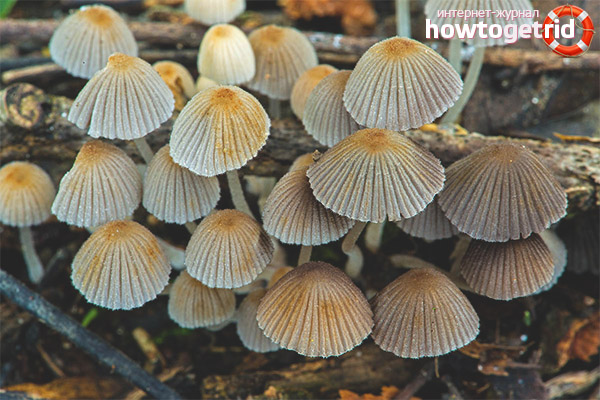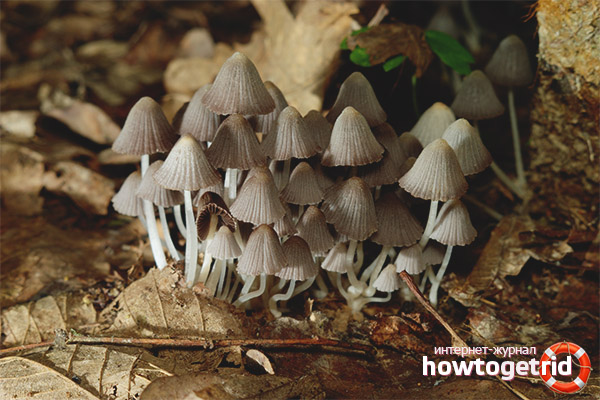The content of the article
By scattered dung beetle is meant an inedible type mushroom that grows in different climatic conditions. Otherwise, this dung beetle is called common, because it is present in forest strips, but never collected and has small dimensions. It is interesting that the soft part of these fruiting bodies is practically absent. Among all 150 varieties of the family, this instance is the smallest.
Description
- The hat is small, very thin and fragile, breaks when handled improperly. Initially, it has the format of an egg, but over time it becomes like a bell. The diameter reaches 1.5 cm. Maximum, but fruiting bodies with an apex from 5 to 12 mm are more common. Stripes are scattered across the surface of the hat. The very surface of the apex with wrinkles, the skin feels velvety and thin.
- As for pigmentation, these fruiting bodies are painted in a dirty whitish tone and its derivatives. That is, they can be slightly beige, light with a gray coating. In the central part, the color is slightly darker than at the edges. The plates protrude sufficiently, wide in structure. Attach to the base. Initially, they are whitish, but the old ones are dark and even black.
- The soft part is watery, extremely delicate and fragile. It breaks when pressed. It is painted white, has no distinctive features by smell. It doesn’t smell at all. The base extends up to 27 mm. The inside is empty, the leg itself is curved, painted in a dirty white tone and quickly crumbles.
Spread
- Despite the fact that this representative of the family is called dung beetle, they do not settle in the appropriate places. In whole colonial clusters, these fruiting bodies live on decayed wood, in particular trees that are already dead or weakened. Trunks are fallen in love closer to the soil and hemp.
- Colonial clusters can also be found on litter in forest belts. They spread near aspen or birch. The life span of fruit specimens is interesting, the duration of existence does not exceed 3 days. They grow very quickly, then turn black and die.
- However, in the summertime, one can see dying specimens on one stump and young growth that has recently appeared. Just a couple of generations, a huge family. The peculiarities of the species include the fact that specimens are never distributed singly.
- In order not to confuse the fruit bodies in question with those of their own kind, you need to know when they appear. The variety is classified as summer type mushrooms. The first representatives are found even in late spring. Fungi continue to bear fruit until the beginning of autumn. If this season is rainy and warm, then there will be specimens in October. However, this is more an exception than routine.
Edibility

As for the possibility of consumption in food, let's say the following. Due to the fact that the fruit part of these fruit bodies is practically absent, one can not hope for excellent taste. Partly for this reason, he is classified as an inedible mushroom. Firstly, a short life. Secondly, there is nothing to feast on. Thirdly, the small size. Also of great importance is the appearance, these dung beetles are ugly, they will not want to put them in a basket. Carrying out their research, experts found that this variety is rich in antioxidants. They, in turn, have some valuable characteristics.
White dung beetle
- Mushroom of conditionally edible category with a shaggy top, painted in a whitish tone. Diameter - 10 cm. This is the maximum value.Initially, the apex format, as a spindle, then smoothly flows into a bell type. Over the course of the life cycle, it does not become widespread.
- The leg is painted in white, extends up to 15 cm in height. It is located strictly in the central part. The inner part is empty, in the middle there is a folding, but it is not always clearly visible.
- White fruiting bodies are found in huge volume. These are whole colonies that grow in glades, garden plots and near houses. They are found on manure and near garbage dumps. Only young animals are subject to collection, until it has become ink.
In today's material, we studied a representative of the mushroom family, who got his “inedible” note because of the lack of pulp as such. It makes no sense to subject these fruiting bodies to gathering and processing, because nothing can be gained from them. A dung beetle is considered white in color, which is reckoned to be conditionally edible specimens and is much more common than its predecessor.
Video: Dung beetle (Coprinellus disseminatus)










Submit